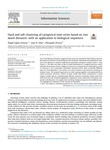Mostrar o rexistro simple do ítem
Hard and soft clustering of categorical time series based on two novel distances with an application to biological sequences
| dc.contributor.author | Lopez-Oriona, Ángel | |
| dc.contributor.author | Vilar, José | |
| dc.contributor.author | D'Urso, Pierpaolo | |
| dc.date.accessioned | 2023-04-10T12:55:51Z | |
| dc.date.available | 2023-04-10T12:55:51Z | |
| dc.date.issued | 2023 | |
| dc.identifier.citation | Á. López-Oriona, J. A. Vilar, & P. D'Urso, "Hard and soft clustering of categorical time series based on two novel distances with an application to biological sequences", Information Sciences, vol. 624, pp. 467-492, 2023. doi:10.1016/j.ins.2022.12.065 | es_ES |
| dc.identifier.uri | http://hdl.handle.net/2183/32840 | |
| dc.description | Financiado para publicación en acceso aberto: Universidade da Coruña/CISUG. | es_ES |
| dc.description.abstract | [Abstract]: Two novel distances between categorical time series are introduced. Both of them measure discrepancies between extracted features describing the underlying serial dependence patterns. One distance is based on well-known association measures, namely Cramer's v and Cohen's κ. The other one relies on the so-called binarization of a categorical process, which indicates the presence of each category by means of a canonical vector. Binarization is used to construct a set of innovative association measures which allow to identify different types of serial dependence. The metrics are used to perform crisp and fuzzy clustering of nominal series. The proposed approaches are able to group together series generated from similar stochastic processes, achieve accurate results with series coming from a broad range of models and are computationally efficient. Extensive simulation studies show that both hard and soft clustering algorithms outperform several alternative procedures proposed in the literature. Two applications involving biological sequences from different species highlight the usefulness of the introduced techniques. | es_ES |
| dc.description.sponsorship | Xunta de Galicia; ED431G 2019/01 | es_ES |
| dc.description.sponsorship | Xunta de Galicia; ED431C-2020-14 | es_ES |
| dc.description.sponsorship | The research of Ángel López-Oriona and José A. Vilar has been supported by the Ministerio de Economía y Competitividad (MINECO) grants MTM2017-82724-R and PID2020-113578RB-100, the Xunta de Galicia (Grupos de Referencia Competitiva ED431C-2020-14), and the Centro de Investigación del Sistema Universitario de Galicia “CITIC” grant ED431G 2019/01; all of them through the European Regional Development Fund (ERDF). This work has received funding for open access charge by Universidade da Coruña/CISUG. The author Ángel López-Oriona is very grateful to researcher Maite Freire for her lessons about DNA theory. | es_ES |
| dc.language.iso | eng | es_ES |
| dc.publisher | Elsevier | es_ES |
| dc.relation | info:eu-repo/grantAgreement/AEI/Plan Estatal de Investigación Científica y Técnica y de Innovación 2013-2016/MTM2017-82724-R/ES/INFERENCIA ESTADISTICA FLEXIBLE PARA DATOS COMPLEJOS DE GRAN VOLUMEN Y DE ALTA DIMENSION | es_ES |
| dc.relation | info:eu-repo/grantAgreement/AEI/Plan Estatal de Investigación Científica y Técnica y de Innovación 2017-2020/PID2020-113578RB-100/ES/METODOS ESTADISTICOS FLEXIBLES EN CIENCIA DE DATOS PARA DATOS COMPLEJOS Y DE GRAN VOLUMEN: TEORIA Y APLICACIONES | es_ES |
| dc.relation.uri | https://doi.org/10.1016/j.ins.2022.12.065 | es_ES |
| dc.rights | Atribución 4.0 Internacional (CC BY 4.0) | es_ES |
| dc.rights.uri | http://creativecommons.org/licenses/by/3.0/es/ | * |
| dc.subject | Association measures | es_ES |
| dc.subject | Biological sequences | es_ES |
| dc.subject | Categorical time series | es_ES |
| dc.subject | Fuzzy clustering | es_ES |
| dc.subject | Hard clustering | es_ES |
| dc.title | Hard and soft clustering of categorical time series based on two novel distances with an application to biological sequences | es_ES |
| dc.type | info:eu-repo/semantics/article | es_ES |
| dc.rights.access | info:eu-repo/semantics/openAccess | es_ES |
| UDC.journalTitle | Information Sciences | es_ES |
| UDC.volume | 624 | es_ES |
| UDC.startPage | 467 | es_ES |
| UDC.endPage | 492 | es_ES |
| dc.identifier.doi | 10.1016/j.ins.2022.12.065 |
Ficheiros no ítem
Este ítem aparece na(s) seguinte(s) colección(s)
-
GI-MODES - Artigos [143]






